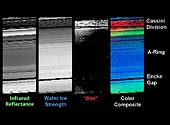|
COMETS EARTH JUPITER KUIPER BELT MARS MERCURY METEORITES NEPTUNE OORT CLOUD PLUTO SATURN SOLAR SYSTEM SPACE SUN URANUS VENUS ORDER PRINTS
PHOTO CATEGORIES SCIENCEVIEWS AMERICAN INDIAN AMPHIBIANS BIRDS BUGS FINE ART FOSSILS THE ISLANDS HISTORICAL PHOTOS MAMMALS OTHER PARKS PLANTS RELIGIOUS REPTILES SCIENCEVIEWS PRINTS
|
Related Documents
Download Options
The visual and infrared mapping spectrometer on the Cassini spacecraft has found evidence for a material dubbed "dirt" in Saturn's rings. The observations indicate that some type of sorting mechanism is concentrating this unidentified material in the gaps between the rings. The images here show the rings just after Cassini successfully entered Saturn's orbit. The infrared reflectance image shows the brightness of scattered light transmitted through the rings. The thicker parts of the rings block more light, while the thinner parts, like the Cassini Division, let more light through. Assuming the rings are made of boulders, they might appear as a multitude of tiny moons. The water ice strength image shows the amount of water in the rings, which appears to peak in the region of the A ring. The "dirt" image shows that the so-called dirty material is most abundant in the thinnest parts of the rings: the Cassini Division, in the Encke and in other small gaps. This material appears remarkably similar to what Cassini measured on Saturn's moon, Phoebe. This color composite is a slightly smeared image in which multiple measurements of the same radial distance are repeatedly measured as indicated by the shallow diagonal banding. For example, the five red dots in the Encke Gap are repeated measurements of the inner edge of the gap. |
